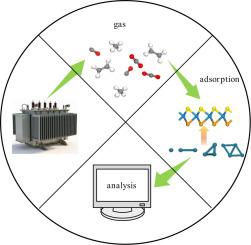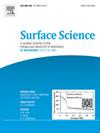Adsorption and sensing properties of Pdn (n=1- 4) doped Janus WSSe for characteristic gases (CO, CO2, CH4, C2H4) in power transformer: A DFT study
IF 1.8
4区 化学
Q3 CHEMISTRY, PHYSICAL
引用次数: 0
Abstract
Power transformers are critical devices, and their dissolved gases can indicate early faults. Based on density functional theory (DFT), this study explores Janus WSSe monolayers doped with Pdn (n=1- 4) for detecting Characteristic gases (CO, CO2, C2H4, CH4). Leveraging the intrinsic asymmetry of WSSe, stability analyses indicate superior doping stability on the S side.The gas sensing properties of Pdn (n=1- 4)- WSSe were elucidated through analysis of adsorption energy, band structure, recovery time, and work function. The results show that the conductivity of WSSe doped with Pdn (n=1- 4) clusters increases significantly, and the adsorption energy of CO, CO2 and C2H4 on Pd3-WSSe reaches the maximum, while CH4 adsorption remains weak. Additionally, the doped systems show favorable recovery times for CO, CO2 and C2H4, while the recovery time of CH4 is relatively short. This study provides a solid theoretical support for the application of Janus WSSe in fault gas detection of power transformers.

Pdn (n=1- 4)掺杂Janus WSSe对电力变压器中特征气体(CO, CO2, CH4, C2H4)的吸附和传感性能:DFT研究
电力变压器是关键设备,其溶解气体可提示早期故障。基于密度泛函理论(DFT),本研究探索了掺杂Pdn (n=1- 4)的Janus WSSe单层,用于检测特征气体(CO, CO2, C2H4, CH4)。利用WSSe固有的不对称性,稳定性分析表明S侧掺杂稳定性更好。通过分析Pdn (n=1 ~ 4)- WSSe的吸附能、能带结构、恢复时间和功函数,阐明了Pdn (n=1 ~ 4)- WSSe的气敏性能。结果表明,掺杂Pdn (n=1- 4)簇的WSSe电导率显著提高,CO、CO2和C2H4在Pd3-WSSe上的吸附能达到最大值,而CH4的吸附仍然较弱。此外,掺杂体系对CO、CO2和C2H4的恢复时间较好,而对CH4的恢复时间相对较短。本研究为Janus WSSe在电力变压器故障气体检测中的应用提供了坚实的理论支持。
本文章由计算机程序翻译,如有差异,请以英文原文为准。
求助全文
约1分钟内获得全文
求助全文
来源期刊

Surface Science
化学-物理:凝聚态物理
CiteScore
3.30
自引率
5.30%
发文量
137
审稿时长
25 days
期刊介绍:
Surface Science is devoted to elucidating the fundamental aspects of chemistry and physics occurring at a wide range of surfaces and interfaces and to disseminating this knowledge fast. The journal welcomes a broad spectrum of topics, including but not limited to:
• model systems (e.g. in Ultra High Vacuum) under well-controlled reactive conditions
• nanoscale science and engineering, including manipulation of matter at the atomic/molecular scale and assembly phenomena
• reactivity of surfaces as related to various applied areas including heterogeneous catalysis, chemistry at electrified interfaces, and semiconductors functionalization
• phenomena at interfaces relevant to energy storage and conversion, and fuels production and utilization
• surface reactivity for environmental protection and pollution remediation
• interactions at surfaces of soft matter, including polymers and biomaterials.
Both experimental and theoretical work, including modeling, is within the scope of the journal. Work published in Surface Science reaches a wide readership, from chemistry and physics to biology and materials science and engineering, providing an excellent forum for cross-fertilization of ideas and broad dissemination of scientific discoveries.
 求助内容:
求助内容: 应助结果提醒方式:
应助结果提醒方式:


